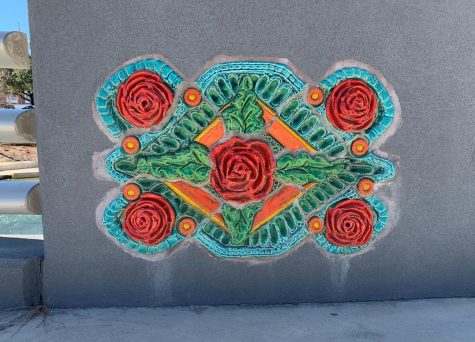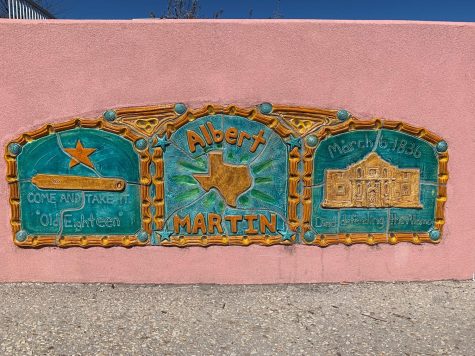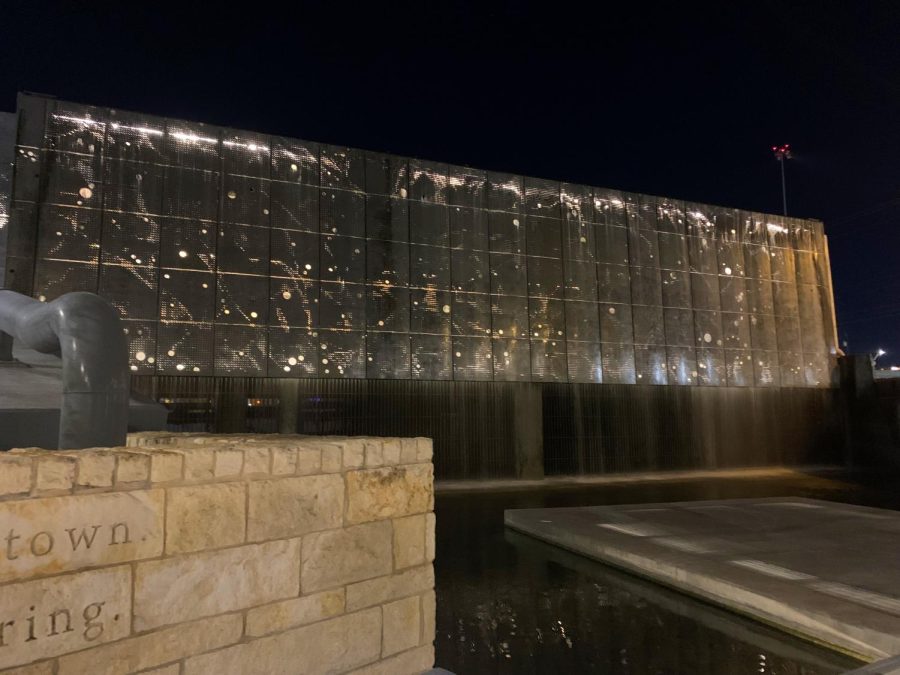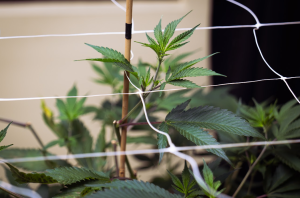Downtown’s San Pedro Creek Culture Park
Multi-phase city project integrates public art, nature and community together
February 15, 2022
Standing beside San Pedro Creek on a cool, sunny day, you cannot help but think of the park’s slogan: “Flowing with Purpose.” San Pedro Creek Culture Park is home to one of San Antonio’s historic treasures and has been established as a natural habitat since 1718. Today, it is under a four-phase construction plan to become a world-class linear culture park where families can come to enjoy the creek’s natural beauty while learning about its culture and history. As you walk along the first completed segment of Phase 1, colorful artwork by San Antonio artists can be seen all around. Whether it is a mural, ceramic, tiled bench or historical text and poetry, they help tell the story of San Pedro Creek and how it came to be the green space it is today. The park also has artistic design features that help flood control for the city and water quality for the wildlife. It is located near the Alamo on the western edge of Downtown San Antonio, and once finished, it will serve a bigger purpose that not only impacts the environment, but also the community and the city.
The project of San Pedro Creek Culture Park started in 2017 and is currently under construction. Only Phase 1, Segment 1, is open to the public and has been since 2018. On San Pedro Creek’s website, they predict that once the park is fully constructed and opened to the public, it will help economic development by creating a $1.5 billion economic impact for the city. Through new business and housing developments, flood control by containing a 100-year floodplain within the creek’s banks and a change in water quality through the addition of bioswales, the park will develop and update their grounds to be more environmentally friendly. On top of expanding the area, aquatic plantings, the removal of floatables and cultural linkage that will be expressed through a series of interactive exhibits, artwork and traditional performances, which aim to breathe new life into the space. This park would not have been possible without the collaboration of Bexar County, the City of San Antonio, the San Antonio River Authority and other government agencies. One can not help but wonder, “How does the artwork, or design features, benefit this creek and city today?” One can find the answers through the San Pedro Creek flood control tunnel artistic installation, and the “Bridges of Understanding” ceramics. They are great examples of how art can help the environment and be permanent depictions of the area’s history.
The top two priorities of San Pedro Creek Culture Park and the San Antonio River Authority are flood control and water quality. The goal is to improve flood safety and the environment by turning the creek into a public amenity and a culture park. Carrie Brown, San Pedro Creek’s Public Art Curator, expressed that while they were planning flood mitigation aspects, like planting aquatic plants to improve water quality, they also included artists to design the park and create spaces for people to come and have events while appreciating the culture and history of the creek.
“We really wanted to kind of unearth those stories, and one of the ways we are doing that is through artwork,” Brown said.
In Phase 1, Segment 1, the San Pedro park has a number of artworks that speak towards the history of the area, the creek’s water flow and the Alameda theater, which was once a thriving cultural center and is now going through its own revitalization. Their hopes are to bring those stories to light and reconnect the community back to the park in a variety of ways. One of those ways is through the artistic design feature, “Rain from the Heavens.” This structure is a stainless-steel panel that pumps water up and over the structure to help filter trash out of the water before it goes into the tunnel underneath.
“Not only does it create a nice sound and a nice visual, but it also actually helps to aerate the water,” Brown said. “So whenever we can do things like that, it is actually helpful for the quality of the water itself.”
The artistic element comes to life at night when the structure is lit for visitors to see. With the partnership of San Antonio College’s Scobee Planetarium, the structure showcases a depiction of what the night sky would have looked like on May 5, 1718, which was when San Antonio was founded. The lights were installed behind the panels to create the starry night sky. It is a great gathering place for people to admire and take pictures, but more importantly, to learn a little bit of history and appreciate how the artistic structure is helping the creek’s environment and wildlife.

“Bridges of Understanding” is a series of ceramics that honor the legacies of the Santa Rosa Avenue, Martin Street and Travis Street bridges. They were created by Diana Kersey, an artist that obtained her MFA in ceramics from Washington State University and specializes in studio pottery, architectural ceramics and public art installations. This project is her fifth public artwork in San Antonio. Kersey has done projects like the “Life Cycle of the Gulf Coast Toad” and the “History of Brackenridge Golf Course.” With her experience and qualification, she was contacted by the architects of the San Pedro Creek project and Muñoz and Co. to do design enhancement. Kersey did not act alone in the creation process of the ceramics. She had the help of Ali Wiesse, who was in an internship with her through the BFA program at the Southwest School of Art. This was Wiesse’s first project with Kersey and she is currently employed and working for Kersey Ceramics.
More importantly, the purpose for the art was to reflect and depict the historical nature of street names. Unlike other public art projects, “Bridges of Understanding” was accomplished differently because she had to get her inspiration from a historic report and use it as a reference point. Each bridge that crosses San Pedro Creek had a different set of ceramics due to its own history.
“Like the Santa Rosa bridge,” Kersey said. “That road leads to Santa Rosa Hospital, and we did a work that responds to that.”
The Santa Rosa bridge has ceramics of beautiful red roses surrounded by other vibrant colors. The second bridge, the Martin St. bridge, has the origin of not having a clarified name. It has been called many different names, such as North Third, then Hidalgo Street and Lakeview Street. Currently, it is called Martin St. in honor of Captain Andrew Martin, who was a combatant in the Alamo. Its ceramics feature all the names it used to be called, including its new name. Finally, Travis Street is the third bridge that was named after William Barret Travis, who was the commander of the Texas army at the Alamo. However, like Martin St., it had been called a different name; Obraje St., in reference to the workshops and factories that inhabited the area years ago. The ceramics on the bridge depict the original name and William Travis. Kersey’s ceramics were dedicated on May 5, 2018, ironically the same month and day San Antonio was founded. She wanted the ceramics to show how the city of San Antonio has evolved and how it has changed over time. Kersey emphasized that she always applies for projects and would apply if San Pedro Creek Culture Park announced an opportunity. She even enjoyed working with Carrie Brown and would be really pleased to work with her again. She is very honored and humbled to be making public art in this community because she loves San Antonio.

“For an artist it’s a really special thing to make something that’s more than likely going to outlive yourself and just become a part of the integrated fabric of our city, [and] I appreciate when those opportunities happen,” Kersey said.
The next segment of Phase 1 is currently under construction. Brown explained there are two more large-scale projects, such as a tile mural and an interactive sculpture, that share the historical theme of cultures coming together, the people who played a role in developing the city and even the musical history of San Antonio. They are scheduled to be installed later this spring. The park’s curator also mentioned there will be a launch to call three new artists later this month for future phases. They are looking for other sculptural, design opportunities and a writer for poetry to be added to the park. This will provide many opportunities for San Antonio and national artists. The park’s purpose is to become a green space where architectural design, historical preservation and local art can be appreciated. San Pedro Creek Culture Park has a historic and cultural identity that will bring people together to view its beauty and importance for generations to come. For more information and current updates, you can check out the park’s website or download their mobile app.









